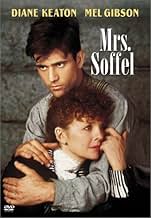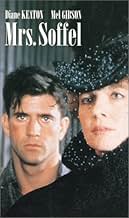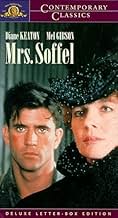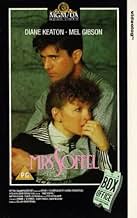CALIFICACIÓN DE IMDb
6.1/10
3.8 k
TU CALIFICACIÓN
Diane Keaton interpreta a la esposa de un alcaide de prisión que se enamora de un condenado a muerte (Mel Gibson). Creyendo que es inocente, le ayuda a él y a su hermano convicto a escapar.Diane Keaton interpreta a la esposa de un alcaide de prisión que se enamora de un condenado a muerte (Mel Gibson). Creyendo que es inocente, le ayuda a él y a su hermano convicto a escapar.Diane Keaton interpreta a la esposa de un alcaide de prisión que se enamora de un condenado a muerte (Mel Gibson). Creyendo que es inocente, le ayuda a él y a su hermano convicto a escapar.
- Dirección
- Guionista
- Elenco
- Premios
- 3 nominaciones en total
Jennifer Dundas
- Margaret Soffel
- (as Jennie Dundas)
- Dirección
- Guionista
- Todo el elenco y el equipo
- Producción, taquilla y más en IMDbPro
Opiniones destacadas
It's 1901 Pittsburgh. Kate Soffel (Diane Keaton) is the wife of prison warden Peter Soffel (Edward Herrmann). Ed Biddle (Mel Gibson) and Jack Biddle (Matthew Modine) are brothers on death row for murder although they claim to be innocent. Kate befriends Ed. It grows into a romance and she helps them escape.
This is based on a true story. It doesn't always make it compelling. I can do with a lot less of the courting in the first half. It is terribly boring and terribly long. It takes an hour before they escape. The escape and the fugitive stages have a bit more tension which this movie sorely needs. As for the romance, it's hard to know Ed's true feelings until they become fugitives on the run. Keaton and Gibson do try to generate some heat at that point. It's a 50-50 proposition. It feels more like a romance novel. The most compelling scenes happen in the last five minutes. It is a very long slough to get there.
This is based on a true story. It doesn't always make it compelling. I can do with a lot less of the courting in the first half. It is terribly boring and terribly long. It takes an hour before they escape. The escape and the fugitive stages have a bit more tension which this movie sorely needs. As for the romance, it's hard to know Ed's true feelings until they become fugitives on the run. Keaton and Gibson do try to generate some heat at that point. It's a 50-50 proposition. It feels more like a romance novel. The most compelling scenes happen in the last five minutes. It is a very long slough to get there.
This one was a nice surprise, I hadn't seen it when it first came out, so I rented it and enjoyed it thoroughly. Diane Keaton and Mel Gibson carry the day in this true tale of a wardens wife who falls for a prisoner. Matthew Modine does a fine job as Mel Gibsons brother, and the entire cast is fine. It's beautifully shot in Pittsburgh, and there is a languid quality about it that I found alluring. Well done all around.
This is a visually beautiful movie bringing the story along in with obvious and subtle references.
The title character is a trapped woman. The 'noblesse oblige'of being the warden's wife coupled with her own frustrations and frailties makes her life intolerable. She loves her children; she hates her life.
Here, she becomes intrigued by a prisoner in her husband's jail. He appeals to her imagination as well as her sensibility as a woman. She finds a soul-mate in their exchanges as she pretends to read-him-to-reform from bible passages. She flees with him and is willing to die with him to keep from returning to her unbearable life.
This is based on a true story. But it is a telling of the story of women, most of whom until the last 25 years or so, had little choice but to marry and to identify themselves in terms of their husbands. Their identity was not their own; their choices had to be appropriate to their marriage station; they were judged by how well they maintained husband's well being and their children's achievements.
While much has changed in women's lives, vestiges of the past still do exist. The references to "baking cookies" in the 2004 presidential campaign signals this.
Mrs. Soffel represents the lives of women over time. She desperately seeks the love and freedom that her standing in life denies her. This has been a common women's theme.
The title character is a trapped woman. The 'noblesse oblige'of being the warden's wife coupled with her own frustrations and frailties makes her life intolerable. She loves her children; she hates her life.
Here, she becomes intrigued by a prisoner in her husband's jail. He appeals to her imagination as well as her sensibility as a woman. She finds a soul-mate in their exchanges as she pretends to read-him-to-reform from bible passages. She flees with him and is willing to die with him to keep from returning to her unbearable life.
This is based on a true story. But it is a telling of the story of women, most of whom until the last 25 years or so, had little choice but to marry and to identify themselves in terms of their husbands. Their identity was not their own; their choices had to be appropriate to their marriage station; they were judged by how well they maintained husband's well being and their children's achievements.
While much has changed in women's lives, vestiges of the past still do exist. The references to "baking cookies" in the 2004 presidential campaign signals this.
Mrs. Soffel represents the lives of women over time. She desperately seeks the love and freedom that her standing in life denies her. This has been a common women's theme.
Australian director Gillian Armstrong makes great films with strong women characters--her earlier Australian film "My brilliant career" being a perfect example. I watched "Mrs. Soffel" because of my admiration for Armstrong and found that "Mrs. Soffel" could not hold a candle to "My brilliant career" even though American actress Diane Keaton was admirable compared to the Australian actresses in the latter.
Armstrong had the talented Australian cinematographer Russel Boyd (who was responsible for the seminal works of Peter Weir and Bruce Beresford) once again to work with. While Armstrong and Boyd used justifiably darkened interior shots, I had problems seeing anything for long periods and had to rely on the soundtrack!
Armstrong loves to develop the female characters but leaves the male characters totally undeveloped (Mr Soffel and Jack Biddle). This is one reason I prefer the works of Weir and Beresford over Armstrong--even though her latent talent cannot be ignored. It is amazing to see Soffel's daughter getting equal or more prominence in the script than Mr Soffel towards the end.
Mel Gibson has made a name for himself by directing "Braveheart," but I give more credence to his acting phase in Australia ("Tim", "Mad Max", etc.). I am convinced that he is a director's actor--doing well with good directors. In "Mrs Soffel" Armstrong has evidently invested time with Diane Keaton, who carries the film. Gibson only lends support to her thanks more to the script than his acting capabilities.
Most of the fine tribe of Australian filmmakers of the Seventies have drifted to the US to become richer and gain international recognition--but their work in Australia in the Seventies remains unsurpassed.
Armstrong had the talented Australian cinematographer Russel Boyd (who was responsible for the seminal works of Peter Weir and Bruce Beresford) once again to work with. While Armstrong and Boyd used justifiably darkened interior shots, I had problems seeing anything for long periods and had to rely on the soundtrack!
Armstrong loves to develop the female characters but leaves the male characters totally undeveloped (Mr Soffel and Jack Biddle). This is one reason I prefer the works of Weir and Beresford over Armstrong--even though her latent talent cannot be ignored. It is amazing to see Soffel's daughter getting equal or more prominence in the script than Mr Soffel towards the end.
Mel Gibson has made a name for himself by directing "Braveheart," but I give more credence to his acting phase in Australia ("Tim", "Mad Max", etc.). I am convinced that he is a director's actor--doing well with good directors. In "Mrs Soffel" Armstrong has evidently invested time with Diane Keaton, who carries the film. Gibson only lends support to her thanks more to the script than his acting capabilities.
Most of the fine tribe of Australian filmmakers of the Seventies have drifted to the US to become richer and gain international recognition--but their work in Australia in the Seventies remains unsurpassed.
Continuing my survey/reevaluation of Mel Gibson movies (well, somebody has to do it), I give this one 3 stars out of 4. If I were giving stars. Anyway...beautifully photographed, nicely-directed film of warden's wife (Diane Keaton) in 1901 Pittsburgh, in contact with death-row inmate brothers (Mel and Matthew Modine). Diane's in static marriage with warden Edward Herrmann and four kids; goes to death row to read Bible passages to cons...one in particular...! Mel's waiting' on a hangin' while the darling of local starry-eyed schoolgirls lamenting the handsome con's apparent fate. Diane and Mel strike sparks in this period romance. Film is slow-moving in first half, but stick with it.
¿Sabías que…?
- TriviaThe jail used in the movie is the actual Allegheny County Jail that figures in the story. Designed by noted architect Henry Hobson Richardson, built between 1884-1888, it served as a jail until 1995 and is now used by the juvenile and family sections of the Common Pleas Court.
- ErroresA toy electric train shown running around a Christmas tree is of a post-1950 design, as is the track. The train is based on 19th-century locomotive and passenger car prototypes, making it more plausible. However, toy electric trains that even remotely resembled the one shown did not exist by 1901.
- Citas
Kate Soffel: Don't you let them take me alive, Ed. Promise me. Promise me, Ed.
Ed Biddle: I won't, I promise. I won't let them take you.
- ConexionesFeatured in The Making of 'Mrs. Soffel' (1984)
Selecciones populares
Inicia sesión para calificar y agrega a la lista de videos para obtener recomendaciones personalizadas
- How long is Mrs. Soffel?Con tecnología de Alexa
Detalles
- Fecha de lanzamiento
- País de origen
- Idiomas
- También se conoce como
- Flucht zu dritt
- Locaciones de filmación
- Productoras
- Ver más créditos de la compañía en IMDbPro
Taquilla
- Presupuesto
- USD 11,000,000 (estimado)
- Total en EE. UU. y Canadá
- USD 4,385,312
- Fin de semana de estreno en EE. UU. y Canadá
- USD 86,280
- 1 ene 1985
- Total a nivel mundial
- USD 4,385,312
- Tiempo de ejecución1 hora 50 minutos
- Mezcla de sonido
- Relación de aspecto
- 1.85 : 1
Contribuir a esta página
Sugiere una edición o agrega el contenido que falta





































